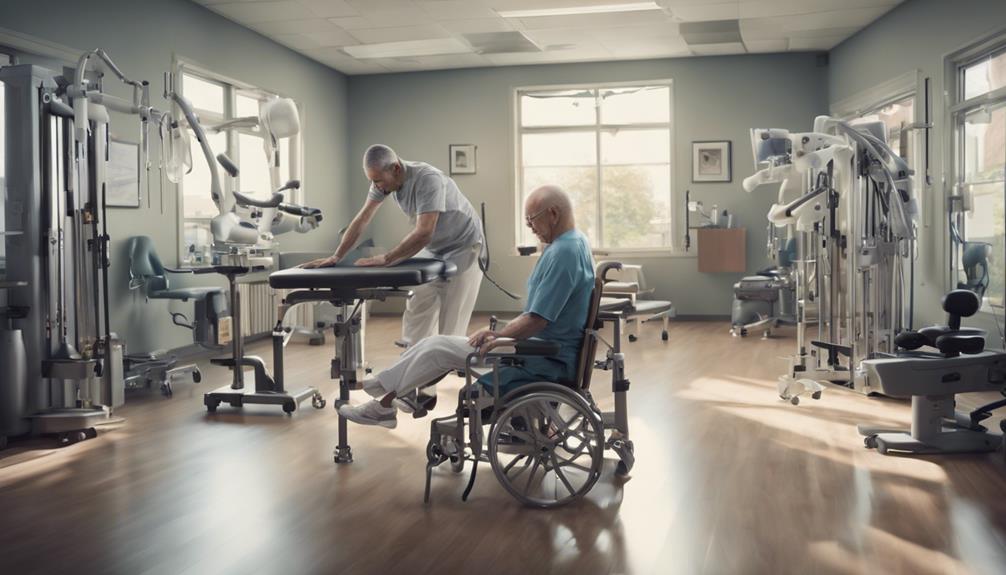Throughout the recovery journey following a spinal stroke, we explore the detailed process of regaining function and achieving independence after this major event.
The journey towards recovery from a spinal stroke is multifaceted, involving various treatment modalities and rehabilitation techniques tailored to each individual's unique needs.
By exploring the nuanced strategies and holistic approaches in this process, we gain insight into the resilience of the human spirit and the remarkable progress that can be made.
Join us on this expedition through the realms of spinal stroke recovery, where hope and determination converge to pave the way for a brighter future.
Key Takeaways
- Integration of physical and occupational therapy crucial for spinal stroke rehab.
- Neuroplasticity and sensory retraining aid in neural pathway rewiring and repair.
- At-home therapy programs like FitMi promote adaptive changes in recovery.
- Emotional support and holistic approaches vital for well-being during spinal stroke recovery.
Understanding Spinal Stroke Rehabilitation
Spinal stroke rehabilitation involves a multifaceted approach that integrates physical and occupational therapy to restore function and promote neural rewiring for recovery. Neuroplasticity, the brain's ability to reorganize itself by forming new neural connections, plays a crucial role in rewiring neural pathways after a spinal stroke.
Sensory retraining is also essential in repairing the sensorimotor system, enhancing sensation, and improving motor function in affected areas. At-home therapy, including full-body exercises like FitMi, is beneficial as it promotes adaptive changes in the spinal cord, aiding in recovery and functional improvement.
Physical therapy focuses on regaining strength, flexibility, and balance, while occupational therapy helps individuals perform daily tasks independently. By engaging in these therapies consistently, individuals have the potential to regain the ability to walk with a walking aid after a spinal stroke, highlighting the importance of dedicated rehabilitation efforts in achieving positive outcomes.
Recovery Strategies for Spinal Stroke

Understanding the importance of consistent rehabilitation for spinal stroke recovery, the implementation of specific recovery strategies is crucial for optimizing outcomes and promoting functional improvement. In the journey towards recovery from a spinal stroke, various strategies play a vital role:
- Physical Therapy: Focusing on enhancing range of motion, building strength, and improving mobility, physical therapy is essential for individuals recovering from a spinal stroke.
- Occupational Therapy: This form of therapy aims at restoring functional independence and helping individuals adapt to any new abilities following a spinal stroke.
- Sensory Retraining: Playing a significant role in repairing the sensorimotor system, sensory retraining aids in enhancing sensation in affected areas, crucial for overall recovery.
Physical Therapy for Spinal Stroke
Implementing targeted physical therapy interventions post-spinal stroke is essential for enhancing mobility, strength, and overall functional abilities. Physical therapy plays a crucial role in spinal stroke recovery by focusing on exercises that stimulate the spinal cord, promoting neuroplasticity and aiding in the restoration of movement. These targeted exercises not only improve muscle strength but also help individuals regain control over their motor functions.
In addition to physical therapy, occupational therapy is integral in spinal stroke rehabilitation, aiming to restore independence in daily activities. Sensory retraining is another vital component of the recovery process after a spinal stroke, focusing on improving both sensation and motor function. At-home therapy programs like FitMi can complement in-clinic sessions by providing full-body rehabilitation exercises that facilitate adaptive changes and aid in the overall recovery journey. By incorporating a combination of physical therapy, occupational therapy, and sensory retraining, individuals can work towards regaining mobility, function, and independence post-spinal stroke.
Emotional Support During Recovery

Receiving adequate emotional support is crucial for individuals navigating the recovery journey following a spinal stroke. Coping with the aftermath of a spinal stroke can be emotionally challenging, and having a strong support system is essential for maintaining mental well-being. Here are key aspects to consider for emotional support during the recovery process:
- Joining Support Groups: Connecting with others who've gone through similar experiences can provide a sense of community and understanding, helping individuals feel less isolated during their recovery.
- Seeking Counseling: Professional counseling can offer a safe space to explore emotions, develop coping strategies, and address feelings of frustration, anxiety, or depression that may arise post-stroke.
- Holistic Recovery Approach: Emotional well-being is a crucial component of holistic recovery after a spinal stroke, impacting the overall quality of life. It's important to address emotional needs alongside physical rehabilitation for a comprehensive recovery journey.
Success Stories of Spinal Stroke Recovery
After establishing a strong emotional support system, exploring success stories of spinal stroke recovery showcases the impact of early intervention and dedicated rehabilitation efforts on achieving optimal outcomes.
Approximately 30% of individuals with spinal stroke can regain walking ability with the help of a walking aid after consistent rehabilitation. These successful stories often underscore the importance of immediate action and commitment to rehabilitation for the best recovery results.
Post-spinal stroke rehabilitation primarily focuses on restoring function through physical therapy, occupational therapy, and sensory retraining. Neuroplasticity, the brain's ability to reorganize itself by forming new neural connections, plays a crucial role in rewiring neural pathways, aiding in the recovery process for spinal stroke survivors.
At-home therapy, such as engaging in full-body rehabilitation exercises like FitMi, can stimulate adaptive changes in the spinal cord and further contribute to successful recovery outcomes. Embracing these success stories emphasizes the significant impact of rehabilitation, neuroplasticity, and at-home therapy in achieving positive results in spinal stroke recovery.
Frequently Asked Questions
What Are the Odds of Recovering From a Spinal Stroke?
We can't provide an exact percentage for the odds of recovering from a spinal stroke since individual outcomes vary. Factors like cause, treatment success, and overall health influence recovery chances.
Rehabilitation, emotional support, and lifestyle adjustments significantly impact the recovery process. While some regain partial or full function, others may require long-term support.
Consistent therapy and assistive devices can help individuals regain mobility and independence post-spinal stroke.
How Serious Is a Spinal Stroke?
Spinal strokes are very serious medical events that can lead to paralysis, loss of sensation, and other debilitating symptoms. The severity of a spinal stroke depends on factors like the location and extent of spinal cord damage.
Immediate medical attention is crucial for a better prognosis and recovery. Spinal strokes can result in long-term complications such as mobility issues, incontinence, and neuropathic pain.
Early diagnosis, treatment, and rehabilitation are vital for optimal outcomes.
Can You Make a Full Recovery From a Spinal Stroke?
We believe that making a full recovery from a spinal stroke is possible. With dedication to rehabilitation and proper medical care, individuals can often achieve significant improvements in their condition.
It's crucial to approach recovery with a positive mindset and follow a tailored rehabilitation program. Progress may take time, but with perseverance and support, many individuals can regain functionality and lead fulfilling lives post-spinal stroke.
Can You Walk Again After a Spinal Stroke?
Yes, with consistent rehabilitation and support, some individuals can regain the ability to walk after a spinal stroke. Dedicated physical therapy and structured programs focusing on restoring mobility and function play a crucial role in enhancing the chances of walking again.
The extent of recovery varies based on each person's condition and response to treatment, highlighting the importance of personalized care and ongoing support in the journey towards walking post-spinal stroke.
Conclusion
In conclusion, spinal stroke recovery is a complex process that requires tailored treatment and rehabilitation strategies. Health professionals must carefully assess each patient’s specific needs and challenges to design an effective recovery plan. By incorporating advanced spinal cord stroke rehabilitation techniques, patients have the potential to regain functionality and improve their quality of life significantly. Ongoing support and adaptive therapies play a crucial role in this journey towards recovery.
It's important to note that 80% of individuals who undergo spinal stroke rehabilitation show significant improvement in functionality and independence.
With the right support, therapy, and determination, individuals can achieve remarkable progress in their recovery journey.
It's crucial to focus on individualized care and consistent effort to maximize recovery outcomes.









